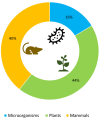Multidrug and Toxic Compound Extrusion Transporters: Ubiquitous Multifaceted Proteins in Microbes, Plants, and Their Interactions
- PMID: 39770636
- PMCID: PMC11676175
- DOI: 10.3390/microorganisms12122433
Multidrug and Toxic Compound Extrusion Transporters: Ubiquitous Multifaceted Proteins in Microbes, Plants, and Their Interactions
Abstract
In recent years, membrane transporters have attracted considerable interest regarding their involvement in the molecular dialogue occurring between microbes and their hosts. In particular, the multidrug and toxic compound extrusion (MATE) transporters form a family of integral membrane proteins, mainly involved in the efflux of toxic and xenobiotic compounds. They are present in all living organisms, both prokaryotes and eukaryotes, where they have a wide array of extremely different roles. In plants, MATE proteins are involved in many important physiological processes, such as plant development, as well as the active transport of several secondary metabolites. In microorganisms, they are mainly implicated in the efflux of toxic compounds and thus contribute to drug resistance. Conversely, information about the actual role of MATE transporters in the interaction between plants and microorganisms, including phytopathogens, is still limited, according to the number of publications available on this topic. Indeed, an understanding of their roles in the plant-pathogen interaction could be essential to increase the knowledge of their molecular conversation and to provide data for the design and development of innovative and sustainable anti-infective strategies to control and manage plant pathogens.
Keywords: MATE transporters; antibiotic resistance; efflux pumps; electrochemical gradient; infective diseases; plant–pathogen interaction; structural biology.
Conflict of interest statement
The authors declare no conflicts of interest.
Figures



Similar articles
-
The multitasking abilities of MATE transporters in plants.J Exp Bot. 2019 Sep 24;70(18):4643-4656. doi: 10.1093/jxb/erz246. J Exp Bot. 2019. PMID: 31106838 Review.
-
Structural biology of the multidrug and toxic compound extrusion superfamily transporters.Biochim Biophys Acta Biomembr. 2020 Dec 1;1862(12):183154. doi: 10.1016/j.bbamem.2019.183154. Epub 2019 Dec 19. Biochim Biophys Acta Biomembr. 2020. PMID: 31866287 Review.
-
Beyond cellular detoxification: a plethora of physiological roles for MDR transporter homologs in plants.Front Physiol. 2014 May 30;5:201. doi: 10.3389/fphys.2014.00201. eCollection 2014. Front Physiol. 2014. PMID: 24910617 Free PMC article. Review.
-
Membrane transporters: the key drivers of transport of secondary metabolites in plants.Plant Cell Rep. 2021 Jan;40(1):1-18. doi: 10.1007/s00299-020-02599-9. Epub 2020 Sep 21. Plant Cell Rep. 2021. PMID: 32959124 Review.
-
Multidrug and toxic compound extrusion (MATE)-type proteins as anchor transporters for the excretion of metabolic waste products and xenobiotics.Xenobiotica. 2008 Jul;38(7-8):1107-18. doi: 10.1080/00498250701883753. Xenobiotica. 2008. PMID: 18668441 Review.
References
-
- Zhao J., Xie H., Mehdipour A.R., Safarian S., Ermler U., Münke C., Thielmann Y., Hummer G., Ebersberger I., Wang J., et al. The Structure of the Aquifex aeolicus MATE Family Multidrug Resistance Transporter and Sequence Comparisons Suggest the Existence of a New Subfamily. Proc. Natl. Acad. Sci. USA. 2021;118:e2107335118. doi: 10.1073/pnas.2107335118. - DOI - PMC - PubMed
Publication types
Grants and funding
LinkOut - more resources
Full Text Sources

